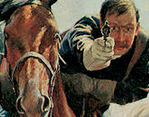My grandfather raised horses. He was a cowboy. Gentle but focused. Pragmatic but passionate. My grandmother fell in love with him the first time she saw him ride in on his big white horse to the town dance in Chandler, Oklahoma.
On the other side of my family tree is Elizabeth Eaton, formerly a Murray. Though prim and proper from the well-to-do Murray’s of St. Louis, she married Frank Eaton, the famous Pistol Pete of Oklahoma State fame.
Frank wrote a book about his life in the “Old West” before Oklahoma became a state. In one episode, Frank and his friends had been captured by indians. One snuck out at night and lit out for Fort Reno to get help.
On the morning of the third day help arrived. Frank describes it this way.
“We saw a cloud of dust rising way up on the trail to the north of us….the calvary was coming.”
Then, Frank describes the the horses.
“The horses were beautiful, mostly bays but some chestnuts and sorrels, and a few blacks, but no paints or other fancy horses. A cavalry horse weighed somewhere around eleven hundred pounds while a cow pony weighed only about nine hundred.”
“When the lead soldiers got within about three to four hundred yards of them the Indians started shooting. The soldiers stopped then and the main column came on up and formed two columns with about four feet between.”
“A Medicine Man was leading the Indians to attack. He had on a war bonnet and was telling them the white man’s bullets couldn’t kill an Indian with a war bonnet on. He was going through all sorts of contortions while he told them he was making the white man’s gunpowder turn to dirt so it would not kill the Indians.”
“An officer with a straight sword, not a calvary saber, in his hand came riding down the line of soldiers. He stopped in front of one of them and pointed with his sword to the Medicine Man. The soldier raised his carbine and sighted, for just a second, then fired; and the Medicine Man pitched head-first off his pony, war bonnet and all, with a bullet clear through him.”
“The soldiers started their horses. They rode at a slow trot at first, then a faster trot, then a run. When they got within about fifty yards of the Indians they raised their guns and fired.”
“The smoke from the guns covered the line of soldiers but when they came out of that smoke and dust every man had his saber in his hand and was riding like the wind.”
“We could see their sabers glitter in the sun…they were making a saber charge.”

“When a calvary horse makes a charge he goes in with his nose and tail straight out and his ears back. He goes straight ahead and nothing stops him unless he is killed. If another horse gets in his way, he just runs over him.”
(left – Charles Schrevogel’s ‘Breaking Through The Line’)
“An Indian in the back broke and ran, then two or three, then fifteen or twenty. After a few minutes of fighting they all broke and ran.”
So what’s all this got to do with thee and me?
Well, today people face problems not Cheyenne Indians. But the problems can be just as life-threatening, certainly job-threatening.
Our team is like the calvary. We keep going until we find the real why that is causing the business problem. It goes like this:
- You tell us the problem situation.
- We gather all the facts we can.
- We dig deeper and deeper until we find the REAL why that is at the root of the problems.
- We design a solution.
- Test it.
- Improve it.
- Implement it.
- Track results.
- Improve it.
- Then fully deploy it.
- Your problems are on the run.
I encourage you to call the calvary, if the “indians” have you surrounded.
We don’t stop until we’ve got solutions implemented and your problems on the run. We’ve solved problems in marketing, training, slow sales, lead generation, non-interruptive marketing…whatever is plaguing a company.
Email me at fletch@theassociation.tv. Better yet, call me. My cell is 818 606-3538.
- See more at: http://blog.theassociation.tv/#sthash.pO8ZJd6I.dpuf
